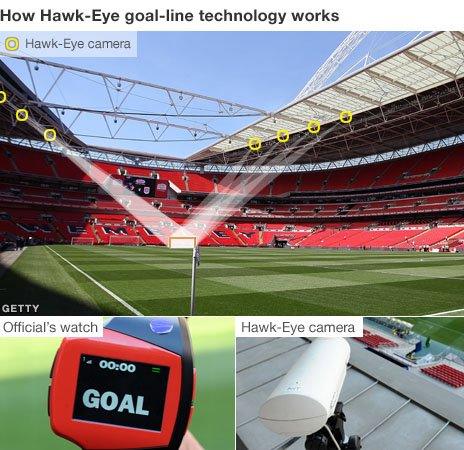Goal-line technology: Premier League votes in favour for 2013-14
- Published
- comments
How Hawk-Eye technology will work
The Premier League has voted to introduce goal-line technology from the 2013-14 season.
British-based Hawk-Eye has been awarded the contract to provide the system.
Hawk-Eye uses seven cameras per goal to detect the ball and claims its system is "millimetre accurate, ensuring no broadcast replays could disprove the decision".

1. Seven fast-frame cameras located above and around each goal, such as on a stadium's roof, track the ball's movement within the goal area. 2. Computer software analyses information from all the cameras and, as soon as it detects the ball has crossed the goal line, sends a signal to the official's watch. The result can be relayed within one second and is said to be millimetre accurate. 3. Hawk-Eye can also provide definitive replays to TV outlets.
The Football Association will install a system at Wembley Stadium in time for August's Community Shield.
Top-flight clubs voted to adopt the system during a meeting of the 20 Premier League chairmen on Thursday.
Hawk-Eye is known for providing tennis and cricket with ball-tracking technology. Its football system notifies the referee if the ball has crossed the goal line via a vibration and optical signal sent to the officials' watches within one second.
Inventor Paul Hawkins said: "It will not slow the game down - it is not going to become like rugby.
"In under a second we will provide the information to the watch, then afterwards we will show a TV replay that will definitively prove what we showed the referee was correct.
"Football's a great game. It does not need enhancements to add to the drama. Our technology is there to ensure decisions are correct."
England manager Roy Hodgson welcomed the Premier League's move, saying it would prevent "gross injustices" affecting results.
"It is something that people in football have wanted for a long time. There's been a big debate, and for a while it was pushed back but now everyone's on the same page and we've introduced it," said Hodgson.
"At least it will stop some of those gross injustices that we have seen in recent years where goals have obviously been scored and not allowed."
Once work is under way, installation of the system for the 17 Premier League clubs who avoid relegation and the three teams promoted from the Football League is expected to take up to six weeks to complete.
Richard Scudamore, chief executive of the Premier League, added: "When these incidents come along, they are so controversial, so seismic, that it is all about getting it right.
"If there is some technology available to help the officials get it right then it is right we should be doing it."
Stoke City chairman Peter Coates also welcomed the decision, but was wary about whether the use of technology should be extended to look at other areas, such as offside decisions.
"I think we should be careful," he said. "The great thing about our game is that it should be simple, free-flowing and that it carries on. We don't want to become like a rugby game, so I'm probably in favour of simplicity and keeping a lot as it is."
West Ham co-owner David Gold was open-minded on further use of the technology.
He said: "It's a start, who knows where it will take us? Fans will have a big say in this, and also TV will have a big say.
"We want to take the big, bad decisions out of football, and this kind of technology will do that. It's been a good day for football."
Momentum for the introduction of goal-line technology increased after Ukraine were denied an equaliser when the ball appeared to cross the line in a 1-0 defeat by England at Euro 2012.
The following month, the International Football Association Board (IFAB) in Zurich approved two systems for use in the sport. At this time the Premier League said it wanted to see its introduction "as soon as is practically possible".
After the IFAB vote, Fifa president Sepp Blatter said Frank Lampard's "ghost" goal at the 2010 World Cup played a decisive role in the decision. Lampard's "goal" came when England were 2-1 down in the second round against Germany. Fabio Capello's team went on to lose 4-1., external
Lampard welcomed the Premier League's decision, saying: "It's a no-brainer. It's been a long time coming but they got here in the end.
"It's a simple thing that will bring an excitement factor when it's used. And it will give you the correct answer which I think, when it's used at this level, is so important. We need that."
- Attribution
- Published12 April 2013
- Attribution
- Published12 April 2013
- Published11 April 2013
- Published9 April 2013
- Published2 April 2013
- Published19 February 2013
- Published28 March 2013
- Published6 July 2012
- Attribution
- Published4 July 2012
- Published6 July 2012